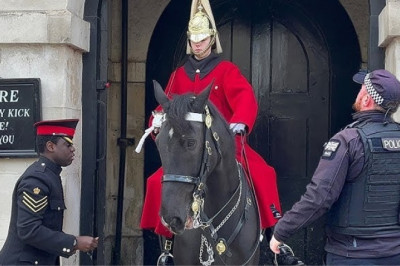
views
How to Tell if a Horse is Friendly: Expert Tips for Equestrians and Horse Lovers
Horses, with their grace and beauty, have been a part of human life for centuries. For those who spend time with these majestic creatures, understanding their behavior is crucial. A friendly horse not only makes riding and handling more enjoyable but also ensures a safe and harmonious relationship. So, how do you tell if a horse is friendly? Here’s what you need to know.
Body Language: The Key to Equine Communication
Horses primarily communicate through body language. Observing their physical cues can give you significant insights into their mood and temperament.
-
Ears: A friendly horse’s ears will usually be relaxed and facing slightly forward or to the sides. If the ears are pinned back, it indicates anger or discomfort.
-
Eyes: Soft, relaxed eyes with a gentle look indicate a friendly horse. Hard, wide-open eyes or showing whites can signal fear or aggression.
-
Nostrils: Relaxed and softly flaring nostrils are a good sign. Tight or pinched nostrils often indicate tension or irritation.
-
Head and Neck: A horse that lowers its head and extends its neck towards you is showing curiosity and trust. A raised head with rigid muscles can indicate alertness or anxiety.
-
Tail: A calm, swinging tail is a positive sign. A horse swishing its tail rapidly or tucking it tightly against its body might be annoyed or scared.
Behavioral Signs of Friendliness
Observing a horse's behavior in different situations is crucial to determining its friendliness.
-
Approaching: A friendly horse will approach you willingly, showing interest and curiosity. It may even nuzzle or sniff you gently.
-
Grooming: Horses that enjoy mutual grooming with other horses often translate this behavior to humans, nibbling or nudging you lightly.
-
Relaxation: A horse that stands quietly with one leg cocked is usually relaxed and comfortable in your presence.
-
Playfulness: Playful behavior, such as running, bucking, or playing with objects, can indicate a happy and friendly horse.
Interaction and Handling
How a horse reacts to being handled is a strong indicator of its friendliness.
-
Leading: A friendly horse follows willingly when led, without pulling away or showing reluctance.
-
Tacking Up: While some horses might always have a bit of a fuss about being tacked up, a friendly horse will generally accept the process without much protest.
-
Mounting: When mounting, a friendly horse stands still and waits for you to settle before moving off.
-
Riding: A horse that responds well to your cues, shows willingness to work, and maintains a steady pace is likely friendly and well-adjusted.
Building Trust and Bonding
Building a bond with a horse takes time and patience. Here are some tips to strengthen your relationship:
-
Consistency: Horses appreciate routine. Being consistent with your handling and riding techniques helps build trust.
-
Positive Reinforcement: Rewarding good behavior with treats, pats, or verbal praise encourages a positive response from the horse.
-
Time: Spending quality time with your horse outside of riding, such as grooming or hand-walking, strengthens your bond.
-
Understanding: Learn to understand your horse’s individual quirks and preferences. This shows respect for their personality and helps build mutual trust.
Expert Tips
Here are some expert tips to enhance your understanding and interaction with horses:
-
Patience: Patience is key when dealing with horses. Rushing or forcing a horse can lead to fear and resistance.
-
Observation: Spend time observing horses in their natural environment. This helps you understand their social dynamics and body language.
-
Training: Proper training not only teaches a horse specific skills but also strengthens your relationship.
-
Health: Ensure your horse is healthy and comfortable. Pain or discomfort can affect a horse’s behavior significantly.
Conclusion
Understanding if a horse is friendly involves observing their body language, behavior, and reactions to handling. Building a strong bond based on trust and respect is essential for a harmonious relationship. Whether you're a seasoned equestrian or a horse lover, these tips will help you connect with your equine friends on a deeper level. So, dive into the world of horse communication and enjoy the rewarding experience of building a strong, friendly bond with these incredible animals.





















Comments
0 comment